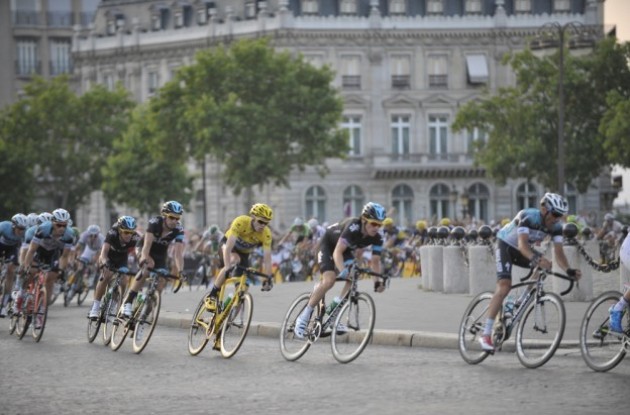What cycling can learn from sailing
They drive carbon fiber machines that cost huge amounts money and have been aerodynamically designed for speed. The athletes wear helmets and wear skin tight clothing adorned with sponsor logos on almost all the available space. The event lasts for two and a half weeks with 19 individual races that determine an overall winner. I could be talking about bike racing. Instead I’m talking about the America’s Cup.
In a stunning finale Team USA’s Oracle AC 17 boat overcame from an eight race deficit to defeat New Zealand’s The Fly Emirates boat. It didn’t take long for commentators to start describing it as one of the greatest sport comebacks in history.
Initially I thought the America’s Cup was a bunch of rich guys racing their expensive toys in the harbor while sipping martinis. Sure, the boats are owned by rich guys – in the case of America’s boat software billionaire Larry Ellison who was reported to have spent an estimated $500 million the last 11 years to win the Auld Mug trophy, the America’s Cup winner’s trophy.
I tweeted a couple of weeks ago, “A boat race is exciting? Really?” I knew I’d take some heat from Twitter as people were worked up about Oracle taking the win. Admittedly I tweet sometimes just to get a rise out of people. As expected I got flak from people describing how exciting the race was, so I decided to take a longer look than the cursory glance I’d taken before.
I watched races 17 and 18 on the America’s Cup YouTube channel and it was exciting to watch. I had to wait until the following day for them to upload the history-making race 19.
While exciting to watch, I was blown away by the production value of the broadcast. The positions of the boats were marked by GPS telling the viewers how much of a lead a boat had. Further, the graphics showed the wind direction, current, and the path they had sailed.
On the boats themselves several mounted onboard cameras brought the action to the viewers. I couldn’t help but contemplate what professional cycling could learn from the America’s Cup.
GPS is used in cycling broadcasts, but there is a lot of room to improve the graphics of the broadcast such as showing wind direction and using on-screen diagraming to show tactics in action. This is going to require a younger commentator who can react and commentate on what could be a rapidly changing race situation.
In addition to the cameras we were able to hear audio from the sailors. While I had no idea of what the terminology meant, what I could understand was the excitement or tension in the voices of the sailors.
There should be some serious thought into putting cameras on select riders, but also in all the team cars. I’ve spent my fair share of time in team cars during races and I’ll be the first to admit that it isn’t an action packed experience (There are plenty of photos of mechanics and journalists asleep in the back seat). I’m suggesting that when there is some excitement they switch to the onboard camera to get the action. Danish television has already done so with select teams during the Tour de France. By doing this, we get the urgency of the wheel change to the excitement of a director when he realizes his rider is about to win. Remember Marc Madiot’s car door pounding enthusiasm during stage 8 of the 2013 Tour de France? How great would that have looked from the inside of the team car? You can’t tell me that wouldn’t have made highlight reels during the evening news.
It’s my understanding that the UCI prohibits the use of onboard bike cameras as it would infringe on broadcasting rights of the race organizers. I suggest everyone get together (by “everyone” I mean the UCI, team owners, and some kind of rider’s representative who actually has some pull) and hammer out an agreement. If new UCI president Brian Cookson is serious about changing cycling, this might be one way to show he’s willing to bring the sport into the 21st century. Roadcycling.com is still waiting for an interview with Mr. Cookson.
This is not to condemn the whole UCI. The UCI has a dedicated YouTube channel which broadcasts races, post-race interviews, and highlights of many disciplines in cycling in high definition – not just road racing.
However, one irritation was that the road world championships broadcast was geo-restricted in the States, so no live viewing for us in the colonies. I suspect that has something to do with a licensing agreement with Universal Sports who broadcasted the race – with highlights available in the videos section here on Roadcycling.com.
Even the most die-hard cycling fans know the first couple of hours of a stage have all the gripping action of a charity ride. For some fans even watching a time trial is a snoozer. Integrating available broadcasting technology into the broadcast booth would only enhance the viewer’s appreciation. Want to explain why the peloton is riding at a 45-degree angle down the road? A graphic showing the wind direction would clearly illustrate the reason. Want to see why a team went to the front? A camera onboard the team car would show the director’s strategy for the move. Again, how exciting would it be to see and hear Brian Holm yelling at his riders to attack – as viewers in Denmark have been able to?
I know this plan can’t happen with the snap of a finger. Some directors aren’t going to be keen about cameras pointed at them for six hours. I also know there are some legality issues that would need to be ironed out so cameras could be mounted on bikes. Also, we’d need a new breed of race commentator who is well versed in the new technology. However, if we don’t even consider new ideas the sport of cycling is going to plod along as new viewers are attracted to other sports. I, for one, am now a fan of America’s Cup and will always tune in.
With the amount of broadcasting technology available cycling needs to leverage it to attract more fans. Sure to the hard core tifosi this might seem like dumbing it down, but it is in fact educating the masses and improving the sport. We need to welcome cycling into a brave new world of sport broadcasting.
While you wait for next America's Cup or bike race to arrive, be sure to have your friends follow Roadcycling.com on Twitter, Facebook and Google+ and gear up for Fall and Winter in our road bike shop. Also, if you enjoy my columns and the rest of Roadcycling.com, please write to your favorite bike brands and tell them to support Roadcycling.com by advertising here.









